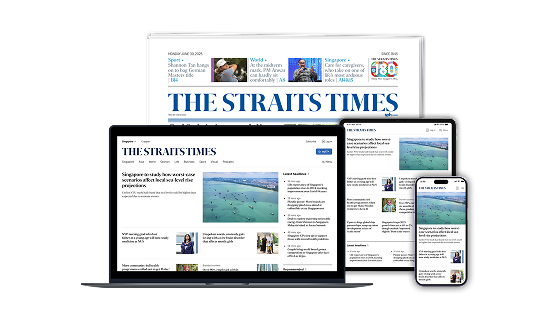North Korea says it has successfully tested new submarine-launched ballistic missile
Sign up now: Get ST's newsletters delivered to your inbox
Follow topic:
SEOUL (AFP, REUTERS) - North Korea said on Thursday (Oct 3) that it had successfully test-fired a "new-type" of submarine-launched ballistic missile (SLBM), state media reported, after Washington voiced alarm at the move just days before the planned resumption of stalled nuclear talks.
"The new-type ballistic missile was fired in vertical mode" on Wednesday in the waters off Wonsan Bay, the Korean Central News Agency (KCNA) reported.
It identified the SLBM as a Pukguksong-3.
The North's leader Kim Jong Un sent "warm congratulations" to research units involved in the launch, which "had no adverse impact on the security of neighbouring countries", KCNA said.
North Korea is banned from ballistic missile launches by United Nations Security Council resolutions, and Tokyo said earlier that a part of the missile landed in waters within Japan's exclusive economic zone.
The test-firing "ushered in a new phase in containing the outside forces' threat to the DPRK and further bolstering its military muscle for self-defence", KCNA said, using a formal acronym for the North.
Photos released in the North's official Rodong Sinmun newspaper showed a black-and-white painted missile emerging and clearing the surface of the water, then the booster rocket igniting to propel it into the sky.
A US State Department spokesman called on Pyongyang to "refrain from provocations" and to remain committed to the nuclear negotiations.
South Korea expressed strong concern and Japanese Prime Minister Shinzo Abe condemned the launch, saying it was a violation of UN Security Council resolutions.
North Korea rejects UN Security Council resolutions that ban Pyongyang from using ballistic missile technology, saying they are an infringement of its right to self-defence.
Talks aimed at dismantling North Korea's nuclear and missile programmes have been stalled since a second summit between Mr Kim and United States President Donald Trump in Vietnam in February broke down in disagreement over nuclear disarmament.
NUCLEAR CAPABLE
The Pukguksong-3 was seen as probably a modification of an earlier version tested in 2015 to enhance range, likely launched from a test platform and not an actual submarine, said Dr Kim Dong-yub, a military expert at Kyungnam University's Institute of Far Eastern Studies in Seoul.
Leader Kim's absence at the test is "extremely unusual", Dr Kim said, adding that it was likely meant to contain the political fallout that could result in the upcoming talks falling apart before they even start.
On Wednesday, South Korea's military said the missile flew 450km and reached an altitude of 910km.
It was likely a Pukguksong-class weapon, as the North's earlier SLBMs under development were known.
South Korean Defence Minister Jeong Kyeong-doo said the Pukguksong, or Pole Star in Korean, would have had a range of about 1,300km on a standard trajectory.
North Korea had been developing SLBM technology before it suspended long-range missile and nuclear tests and began talks with the US that led to the first summit between Mr Kim and Mr Trump in Singapore in June 2018.
The latest version of the Pukguksong may be the longest-range North Korean missile that uses solid fuel and the first nuclear-capable missile to be tested since November 2017, Mr Ankit Panda of the US-based Federation of American Scientists said.
North Korea has been developing rocket engines that burn solid fuel, which has advantages in military use compared to liquid fuel because it is stable and versatile allowing it to be loaded in missiles until they are ready for launch.

